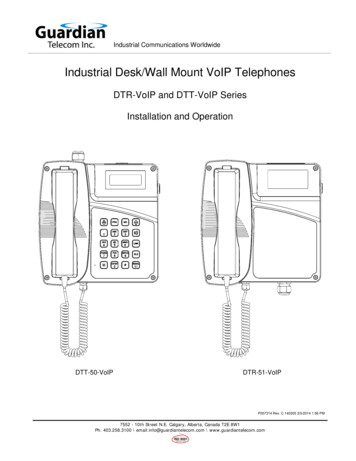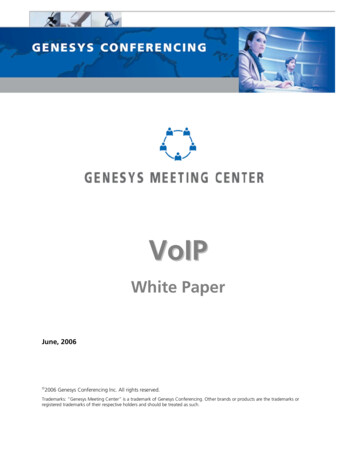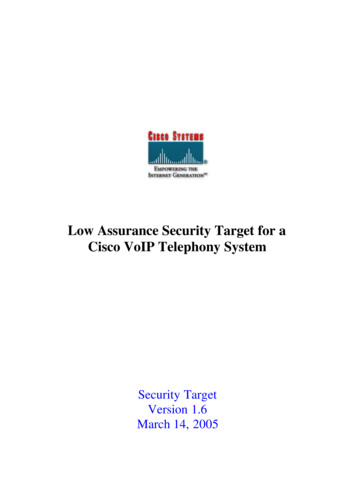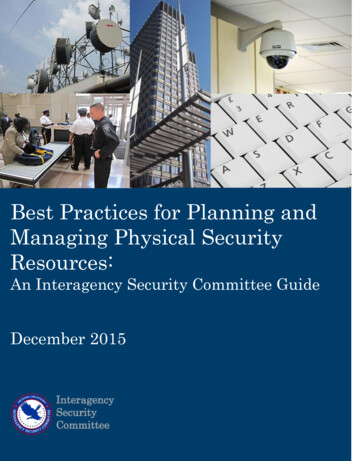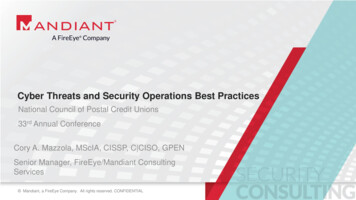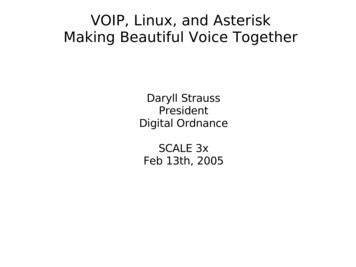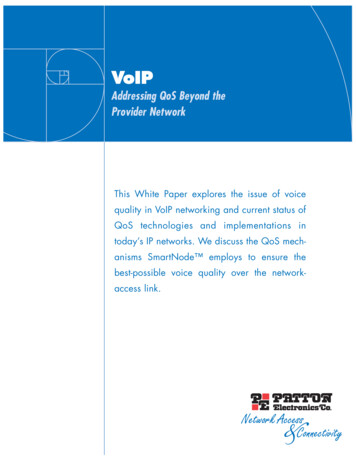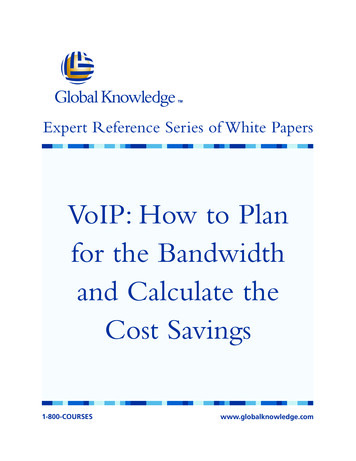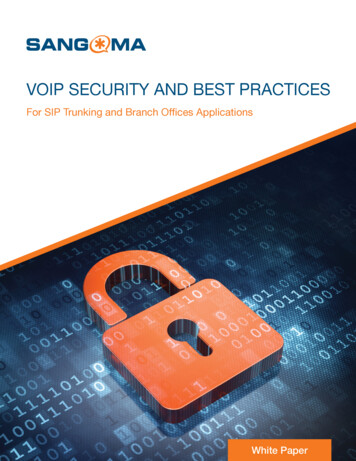
Transcription
VOIP SECURITY AND BEST PRACTICESFor SIP Trunking and Branch Offices ApplicationsWhite Paper
VoIP Security and Best PracticesTABLE OF CONTENTSOVERVIEW . 1WHY SECURITY IS IMPORTANT WITH VOIP . 2SIP TRUNK SECURITY WITH FIREWALLS . 8SIP TRUNK SECURITY WITH SESSION BORDER CONTROLLERS . 2REMOTE IP-PHONES SECURITY WITH FIREWALLS . 2REMOTE IP-PHONES SECURITY WITH SBC . 2REMOTE IP-PHONES SECURITY USING VPN . 2CONCLUSION: THE BEST SECURITY STARTS WITH A SECURITY POLICY . 2White Paper Copyright 2018 Sangoma Technologies. All rights reserved.ToC
VoIP Security and Best PracticesOverviewThis document will bring knowledge to IT & VoIP Administrators about VoIPSecurity specific to SIP Trunking and Remote Phone applications. Topicssuch as understanding what some types of VoIP Attacks are, and how todeploy VoIP Security solutions in common applications such as SIPTrunking and Remote Phones. In the end, no one device is responsible forVoIP Security, but rather all VoIP devices and solutions must have someresponsibly to overall VoIP Security. This document complements commoncomputing security implementations and expands into various ways toimplement VoIP Security and discuss what features can be used on thesedevices to best deploy a secure VoIP Solution.To understand the need for VoIP Security, you first need to understand the types of VoIP attacks andthreats presented on the network. Topics such as the availability of access to VoIP and the varioustypes of directed and indirect attacks on VoIP solutions and devices. Discovery of VoIP solutions bymeans of Reconnaissance, then denial of VoIP Services by means of Denial of Service attacks, andthe most common Toll Fraud.One major application of VoIP is SIP Trunking. SIP Trunking is typically a Peer to Peer relationshipbetween the Service Provider and Enterprise. Topics specific to securing SIP Trunking will bediscussed, securing SIP Trunking solutions with a Firewall only, and also with a Session BorderController. In both methods, even the IP-PBX has a role to play to provide a secure SIP Trunkingsolution.Another major application is the deployment of Remote Phones in branch offices or work-from-homesituations. Remote phone deployments are dynamic in nature, with phones registering abroad to acentral IP-PBX, where the location of the Remote Phones is constantly changing and updating. Thereis also the type of traffic to and from the phones which is vastly different than a SIP Trunk with all thedynamic call control requirements. Topics specific to securing Remote Phones will be discussed, aswill solutions with Firewalls only and the use of a Session Border Controller. And it bears repeating inboth of these methods, the IP-PBX still has a role to play in providing a secure remote phone solution.White Paper Copyright 2018 Sangoma Technologies. All rights reserved.1
VoIP Security and Best PracticesWhy Security is Important with VoIPSecurity is one of the most frequently discussed topics, yet the importance of securing VoIP is hard tooverstate. In this section, topics will include a few of the more prominent reasons why VoIP Security isso important, by understanding some of the common threats. Due to VoIP solutions and servicesgrowing, there is more attention to understand the types VoIP attacks and to counter with variousmethods when deploying VoIP security solutions. Every device and service are in part responsible forproviding a secure VoIP solution, but there are a few different ways to deploy a secure VoIP solution.End of GeographyTraditional telephony delivered via analog or digital involves transmission over some physical medium.Security attacks to traditional telephony such as eavesdropping required physical presence withaccess to the physical lines.Toll Fraud over traditional telephony has several forms, one common attack was to hairpin telecomtraffic. This is when inbound calls into a voice network weresent back out to an alternate destination.Now that Voice Networking has merged with Computer Networking there is an “End of Geography”.Physical presence is no longer required to gain access to a voice system. Computer Networking is anOPEN network system, as any IP Address can connect with any other IP Address.IP Protocol (IPv4 RFC 791 & IPv6 RFC 8200) and IP Addresses are fundamental in both public andprivate networks used in everyday communications for both voice and data. This leads to computernetworking attacks having tremendously more access and tools available to conduct malicious attackson VoIP infrastructures.White Paper Copyright 2018 Sangoma Technologies. All rights reserved.2
VoIP Security and Best PracticesCarriers and businesses are concerned about exposing VoIP resources and VoIP information tohackers. Obviously, the exposure of VoIP resources over the Internet (public) is required, but internal(private) also needs some attention. A method is needed to prevent fraudulent VoIP activities betweenpublic and private Networks, monitoring and securing VoIP traffic.Firewalls have become ubiquitous in the deployment of computer networks, for implementing Securitypolicies and for the protection of private networks and business services. Voice applications overcomputer networking is growing substantially and requires similar implementation for the protection ofprivate networks. Firewalls do not have the needed Real-Time and Protocol Security requirements forVoIP, but Firewalls still need consideration when deploying VoIP as they are a part of every networkdeployment. Session Border Controllers are better at providing VoIP Security and can work tocomplement Firewalls in providing a complete security solution.Types of AttacksAnalogies between War tactics and Internet Security are becoming more common as the proliferationof attacks on Internet services increase in strength and diversity. Part of these attacks are focused onVoIP Attacks of various types and strength. This section discusses various types of VoIP Attacks andtheir purpose. What is the Hacker trying to accomplish with the attack?ReconnaissanceIn many cases the first component of an attack is the search for VoIP services. Port Scans and otherdirected VoIP discovery scans search through the Internet looking for VoIP Services. The hackers’White Paper Copyright 2018 Sangoma Technologies. All rights reserved.3
VoIP Security and Best Practicesobjective is to search through the range of IPv4 and IPv6 IP Addresses looking for VoIP Services totarget with other forms of attacks. Once a VoIP Service is discovered, other types of attacks can thenfollow. It is best to understand the tools and methods used to discover VoIP Services and simplydetect these methods and not acknowledge the VoIP Service back to the hacker. If the hacker doesnot know there is VoIP Service, they are most likely going to overlook and move on.Toll FraudVarious forms of Toll Fraud have been around since the infancy of telecommunications. Toll Fraud is atype of Intrusion of Service. Within VoIP, Toll Fraud has more possibility of exposure, as VoIP Serviceshave more accessibility throughout the Internet. Toll Fraud has several different scenarios, thisincludes the hairpin of calls through an IP-PBX, as well as spoofing Carriers as legitimate customers.In every case the intension of the hacker is to avoid paying carrier billing by directingtelecommunications traffic through someone else’s service.Intrusion of ServiceThe forcible act by a hacker to gain access to the VoIP Service is a common type of attack. Thehacker gains access to the IP-PBX by registering a phone or application to the IP-PBX. Then acting asa valid extension, they can make calls as a local extension or disrupt normal operation by leavingvoicemails or sending broadcasts to other users. Spoofing, Identity Theft, and SPIT are some specifictypes of Intrusion of Services.SpoofingSpoofing is when a hacker attempts to mimic the attributes, such as a VoIP Phone or SIP Trunkingservice and uses their own Spoofing device to make calls into the IP-PBX. The hacker attempts toWhite Paper Copyright 2018 Sangoma Technologies. All rights reserved.4
VoIP Security and Best Practicesmimic attributes such as IP Address, Endpoints, Username and Password of an existing device orservice. Or on a lesser extent, mimicking the IP-PBX and calling the phone directly or calling the SIPTrunk provider directly.Identity TheftSimilar to Spoofing, but slightly different, is Identity Theft – also called Phishing. Although the termsSpoofing, and Phishing may sound similar, Phishing attacks generally use Spoofing as a strategy tosteal information; however, Spoofing attacks are not necessarily Phishing. Spoofing attacks can beused to cause damage without stealing information. Identity Theft is where the hacker has stolen theidentity of a legitimate party and poses as them. They can then take the configuration of a remotephone endpoint and makes calls posing as the legitimate phone to get access from the VoIP Server. Inmany cases, this is accomplished by obtaining the configuration files from the provisioning server ontheIP-PBX.White Paper Copyright 2018 Sangoma Technologies. All rights reserved.5
VoIP Security and Best PracticesSPITSPAM over Internet Telephony (SPIT), once the hacker has either Spoofed or Phished their way intothe IP-PBX, they begin calling every possible number with the intension of broadcasting a prerecorded message or simply using or changing Voicemail, Auto-attendant and Conference resources.Just as the name suggests “SPAM”, but this time SPAM using VoIP technology to deliver unwantedmessages.Denial of ServiceDenial of Service is when the hacker seeks to make the VoIP Service unavailable to its intended usersor carriers by temporarily or indefinitely disrupting services connected to the Internet. Typicallyaccomplished by flooding the targeted VoIP Service with superfluous VoIP and other requests tooverload systems and prevent the legitimate service from being operational.White Paper Copyright 2018 Sangoma Technologies. All rights reserved.6
VoIP Security and Best PracticesEavesdroppingEavesdropping is a very time-consuming process for a low return but has a high impact. It typicallyinvolves a number of different compromised endpoints and/or network devices – a Man-In-The-Middletype attack. When Hackers want to listen to VoIP conversations they need to record the media stream.The attack is performed similarly as capturing any other type of traffic travelling across the Internet,finding compromised devices to record directly from or stream the media to a recording device.White Paper Copyright 2018 Sangoma Technologies. All rights reserved.7
VoIP Security and Best PracticesSIP Trunk Security with FirewallsSIP Trunking is often a Peer to Peer connection for the primary use of delivering PSTN connectivityover VoIP. SIP Trunking is delivered over a couple of different methods, Internet Telephony ServiceProviders (ITSP) deliver SIP Trunking over the Internet and Managed Service Providers deliver SIPTrunking over the dedicated carriers WAN connections. The application of security solutions involvesproviding a Firewall in combination with an IP-PBX that are used to define the Peer to Peerrelationship at various networks and VoIP application layers, and also ensuring signaling and mediaare secure as well.In the example below, the IP-PBX resides behind a typical network Firewall. The Firewall is the borderelement between Internet or Untrusted Network Zones and Local Area Networks or Trusted Zones.The Firewall is a network security device that monitors incoming and outgoing network traffic anddecides whether to allow or block specific traffic based on a defined set of security rules.White Paper Copyright 2018 Sangoma Technologies. All rights reserved.8
VoIP Security and Best PracticesFirewall Features & SetupThe Firewall controls the traffic by redirecting SIP signaling and Audio Media streams to the defineddestinations. In this solution the Firewall is controlling communications for allowing SIP Trunk trafficfrom carriers to be directed into the IP-PBX.Port ForwardingOne of the primary functions of a Firewall is to Deny ALL unsolicited traffic from Untrusted Networks.To work around this, firewalls provide Port Forwarding or Port Mapping that redirects a communicationrequest from one UDP/TCP IP address and port number combination, to another while the packets aretraversing a Firewall. Also, Port Forwarding and NAT does not validate or inspect if the packet beingsent is the application for intended use. If the Firewall receives any UDP or TCP packet, it will redirectthe packet to the defined destination, no matter the content within the packet.Access Control ListsInstead of allowing any packet to redirect through the firewall with Port Forwarding, the firewall typicallyhas configuration that will define a Source IP Address(es), whereby the UDP/TCP packet within theSource IP Address must match the defined value. Essentially creating an Access Control List (ACL),which is useful in the Peer to Peer SIP Trunking application as one peers IP Address can be acceptedand redirect to a defined destination. The limitation is the use of Domains, where the source IPaddress can be dynamic.White Paper Copyright 2018 Sangoma Technologies. All rights reserved.9
VoIP Security and Best PracticesSIP Protocol typically operates on UDP/TCP Port 5060. SIP signaling messages are sent from onepeer and redirected to another peer on this UDP/TCP port. Thus, setting up a Port Forward of the SIPProtocol from one peer to another to allow the SIP messaging. Audio Media RTP Packets can operateon any UDP port, but typically from 10,000 up to 30,000. That is a tremendous amount of ports to PortForward and could limit other applications use of these ports. This is not always a viable solution, andnot very secure as tens of thousands of ports are open on the firewall and directed to the IP-PBX.In addition, spoofing source IP Address is the most common and easiest ways to bypass AccessControl Lists on Firewalls, it is easy to setup spoofing IP Addresses on many computer operatingsystems. Be aware that ACL should not be the only security feature in operation. Keep in mind thatSIP Protocol is an Application Layer protocol of the OSI Model and addressing is independent ofTransport Layer IP Addresses. Spoofing the IP Address will have little to no effect on the SIPAddressing of the VoIP.SIP ALGSome Firewalls have a built in SIP Protocol Application Layer Gateway (ALG), also called SIP Helpers.SIP Protocol resides in the Application Layer of the OSI Model. A SIP ALG is a basic SIP ProtocolApplication feature that changes Private IP Addresses to Public IP Address. ALGs are rudimentary atbest, they are stateless as they don’t understand the state of the call, and often have undesired effectson SIP calls that are more complex than a basic call. It is recommended to turn SIP ALGs off orconsider using a Session Border Controller. More importantly, as ALG simply help SIP signaling totraverse NAT’ing firewalls and other Interoperability needs, they typically don’t offer any securityrelated features.IP-PBX Features & SetupIn this scenario, the Firewall is the initial control point for the voice traffic, but the Firewall is not verystrong in VoIP Security. Firewalls can provide IP Address level of Security with ACL, but everythingelse is simply Port Forwarded, which is like Poking a Hole in the Firewall. The IP-PBX will bear thebrunt of directed VoIP attacks and will require VoIP security features, the IP-PBX becomes the mainWhite Paper Copyright 2018 Sangoma Technologies. All rights reserved.10
VoIP Security and Best PracticesVoIP Security device. This may cause the IP-PBX to use valuable IP-PBX Server resources, such asCPU and Memory for running the VoIP communications of the business and CPU dedicated topreventing an attack.The Firewall will assist in securing the VoIP environment, but this solution the IP-PBX has a major roleto play in securing the overall VoIP environment.IP-PBX FirewallAs we discussed earlier, a Firewall is a network security application that monitors and controlsincoming and outgoing network traffic based on predetermined security rules. When a Firewall isimbedded as an application within an IP-PBX, the Firewall typically establishes a barrier between atrusted internal network and untrusted outside network, such as the Internet. A Firewall on the IP-PBXis focused on network identifications and determining if these networks are Trusted or Untrusted andapplying access policies.IP-PBX Firewalls must also responsive to VoIP, where if the registration attempt from a Phone or Peeris successful, the remote host is then added to a 'Known Good' zone, that has permission to use thatprotocol, and is additionally granted access to UCP, if UCP is enabled. If the incoming connectionattempts are invalid from the Phone or Peer, traffic from that source device will be dropped for a shortperiod of time. If attempts to authenticate continue without success, the attacking host will be blocked.IP-PBX Firewalls must also be flexible in defining Trusted and Untrusted Zones not only for VoIPServices like SIP and RTP, but also for other management and configuration services like SSH andHTTP. For example, to Allow SSH and HTTP on local Trusted Zones, but not Untrusted Zones.IP-PBX Firewalls must be allowed to predetermine and manage Blacklists. A Blacklist is a list ofnetwork addresses that are in a permanent Deny All policy. Where any IP Address(es) defined on theBlacklist will not have any communication with the IP-PBX.White Paper Copyright 2018 Sangoma Technologies. All rights reserved.11
VoIP Security and Best PracticesIntrusion DetectionAn Intrusion Detection System (IDS) on an IP-PBX is an application that monitors communication intothe IP-PBX for malicious activity or policy violations. Any detected activity or violation is typicallynotified to the IP-PBX administrator. Typical IDS policies include Registration Attempts, PasswordFailure Attempts, SIP Packet signature detection (known patterns), and anomaly detection (deviationsfrom good traffic). The Intrusion Prevention System (IPS), usually associated with the IDS, acts as theautomated response system by proactively denying the malicious activity upon detection. This includesterminating connections and blacklisting offending parties.Specifically, in this scenario where the IP-PBX resides behind a Firewall and the Firewall is PortForwarding UDP/TCP traffic to the IP-PBX, the IP-PBX must have IDS/IPS to detect and protect fromRegistration Attempts, Password Failure Attempts, SIP Packet signature detection, and anomalydetection.Port ManagementVarious applications within the IP-PBX use datagram sockets to establish host-to-hostcommunications. An IP-PBX application binds a socket to its endpoint of data transmission, which is acombination of an IP address and a service port. For complete operation of an IP-PBX the ServicePorts may include SIP Protocol (5060), HTTP (80), HTTPS (443), FTP (23), SSH (22) and plentymore. It is important to turn on only the Ports needed, and leave the optional Port disabled. Also,where possible, to use custom Ports for common applications, such as HTTP (port 80) for WebGUIAdministration access is e
White Paper VOIP SECURITY AND BEST PRACTICES For SIP Trunking and Branch Offices Applications
